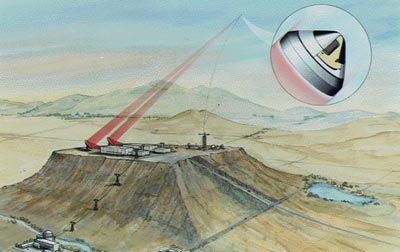By Guest Blogger, Nathan Edge
This month Nathan Edge discusses the nature and operation of nuclear devices being used in unmanned space operations. As an aside, I can't believe I wasn't the first person to type into Google, "nuclear engine...USS Enterprise"?! Nathan provides links to sites for more information throughout the piece. Anyway, on with the article!
Nuclear power
isn’t just applicable to terrestrial electricity generation; it has also been
used in space travel since 1961 – whereby it is still a tremendous source of
potential for propulsion mechanisms. Many well known space vehicles such as the deep space probes
Voyagers 1 & 2 – which
are over 18,000,000,000 and 15,000,000,000 km from Earth respectively –
rely on nuclear power. It is even being used on NASA’s Curiosity Rover, which
made a spectacular
touchdown on Mars last year.
 |
| Voyager 2. One of the most distant man-made objects in existence. |
The popularised
spacecraft don’t actually use conventional nuclear reactors. Radioisotope
thermoelectric generators (RTGs) - which harness Plutonium-238 as fuel - are
the primary propulsion source. These so-called “nuclear batteries” exploit the
principle that plutonium undergoes alpha-decay to produce heat. This is
subsequently converted in to electricity using thermoelectric
generators. Since they have no moving parts, RTGs are very reliable; the
RTG on Voyager 2 has worked
continuously since 1977, and is expected to continue working until 2025.
 |
| A general RTG configuration |
This is not to
say, however, traditional nuclear reactors have not also been used in space
operations in the past … albeit with some serious modifications. For example,
the Soviet
RORSAT satellites used 90% enriched uranium fuel as a power source. The
safety implications of using such a system in earth orbit are obvious, and any
fears of utilising such a technology are not exactly unfounded. The nuclear-powered
Cosmos 954 satellite, for instance, fell
into Canada in 1978 after a systems failure,
distributing
radioactive debris over 124,000 square kilometres.
Due
to events like these, it is likely that any future reactors will be confined to
deep space like RTGs. However, this does not mean that they will only be used
for unmanned exploration probes. NASA
has its eyes on a manned Mars mission, but traditional chemical rockets
would take six to seven months to reach Mars. A 1MW fission reactor powering
100-400 kW electric ion thrusters would take 3 months,
thus limiting the health
degradation astronauts face on long space journeys.
Modern RTGs are
designed to survive the possible accidents which could befall it during
operation, including propellant fires during launch and land/water impacts.
Reassuringly, RTGs cannot explode like nuclear weapons: the plutonium
associated with weapons is Pu-239, not Pu-238. A similar safety feature which
has been specified for nuclear reactor propulsion tech is that they are not activated until they are
confirmed to have reached space successfully. Ultimately, this is to ensure
fission fragments and other components of nuclear waste are not present if
failure occurs during launch.
 |
| Space: The future of waste disposal? |
Lastly, when
using an RTG some additional thought must be applied to the disposal of the
spacecraft when they come to the end of their working life. This is not just a
nuclear issue: it’s important not to disturb any areas which potentially
harbour extraterrestrial life. For example the RTG-powered Galileo spacecraft
was sent into Jupiter’s
atmosphere and destroyed to stop it crashing into a potential ocean under
Europa’s crust. The disposal of RTGs and future nuclear reactors actually touch
on one of the more outlandish proposals for dealing with nuclear waste: firing it out of the solar
system.
In short, the
space and nuclear industry have a surprising legacy: nuclear power has already
been used successfully for near-earth and deep space missions in the past, and
its use has continued into the cutting edge-missions of today. Only time will
tell whether or not it is the key to future exploration, both manned and
unmanned, into our universe.
DOCUMENT
LINKS (IN ORDER OF APPEARANCE)
NASA, 2013 Where are the
Voyagers? [online]. Available at: http://voyager.jpl.nasa.gov/where/index.html
[Accessed 02/02/2013]
Atmos, J. 2012. Curiosity
rover made near-perfect landing [online]. Available at: http://www.bbc.co.uk/news/science-environment-19219782
[Accessed 02/02/2013]
Snyder, G.J. Small
Thermoelectric Generators [pdf]. Available at: http://www.electrochem.org/dl/interface/fal/fal08/fal08_p54-56.pdf
[Accessed 02/02/2013]
NASA, 2013. Voyager –
Spacecraft Lifetime [online].Available at: http://voyager.jpl.nasa.gov/spacecraft/spacecraftlife.html
[Accessed 03/02/2013]
Encyclopaedia of Science, 2013. RORSAT
(Radar Ocean
HackCanada, 2013. Cosmos 954
Satellite Crash [online]. Available at: http://www.hackcanada.com/canadian/other/cosmos954.html
[Accessed 10/02/2013]
King, L, 2012. Manned Mars
mission still on track [online]. Available at: http://usatoday30.usatoday.com/tech/story/2012/09/12/manned-mars-mission-still-on-track/57767950/1
[Accessed 11/02/2013]
Rousseau, I.M. 2007. Analysis
of a High Temperature Supercritical Brayton Cycle for Space Exploration [pdf].
Available at: http://web.mit.edu/rsi/www/pdfs/papers/2005/2005-ianr.pdf
[Accessed 01/10/2012]
Discovery, 2013. Known effects
of long-term space flights on the human body [online]. Available at: http://www.racetomars.ca/mars/article_effects.jsp
[Accessed 10/02/2013].
US Department of Energy, 1982. Nuclear
Safety Criteria and Specifications for Space Nuclear Reactors [pdf].
Available at: http://www.fas.org/nuke/space/osnp-1.pdf
[Accessed 20/02/2013].
NASA, 2013. Solar system
exploration -Galileo Legacy Site [online].
Available at: http://solarsystem.nasa.gov/galileo/
[Accessed 21/02/2013].
The Space Review, 2013. Nuclear
waste in space? [online]. Available at: http://www.thespacereview.com/article/437/1
[Accessed 22/02/2013]
IMAGES
Space Today Online, 2011. Voyagers
are leaving the Solar System [online]. Available at: http://www.spacetoday.org/SolSys/Voyagers20years.html
[Accessed 02/02/2013].
Wikipedia, Radioisotope
thermoelectric generator [online]. Available at: http://en.wikipedia.org/wiki/Radioisotope_thermoelectric_generator
[Accessed 02/02/2013]
Gunter’s Space Page, 2013. US-A
[online]. Available at: http://space.skyrocket.de/doc_sdat/us-a.htm
[Accessed 05/02/2013]
The Space Review, 2013. Nuclear
waste in space? [online]. Available at: http://www.thespacereview.com/article/437/1
[Accessed 22/02/2013]
